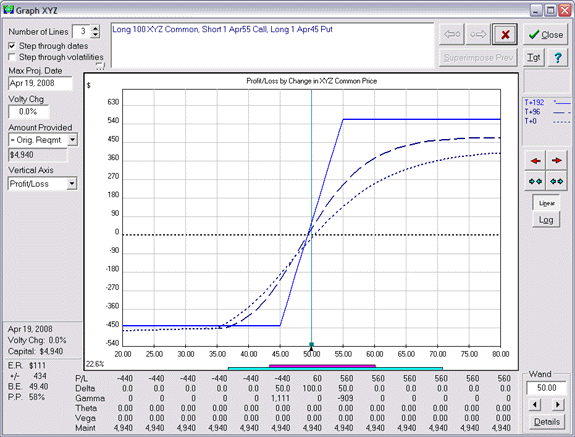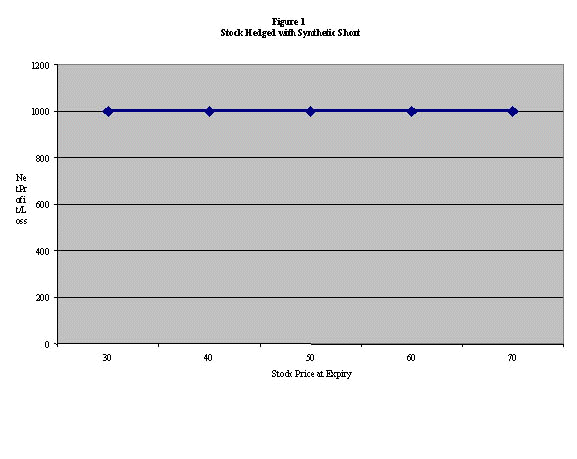The NetCredit Collar
Post on: 16 Март, 2015 No Comment

Larry McMillan continues the collar series with examples of this variety.
In The Basics of the Collar Strategy . we defined a few terms: macro protection, micro protection, and collars. If you’re not familiar with those terms, please read my first post before continuing. You may also find it helpful to see Play #8 in the online version of The Options Playbook . located in TradeKing’s Education Center . In this segment, I will discuss the net-credit collar and provide several examples. This is when the call is sold for more than the cost of the put, resulting in a combined net-credit option trade.
Collar entry cost: $0.65 net-credit
Stock price at option entry: XYZ is near $100 per share
Maximum gain: $30.65 (Strike B — current stock price + net-credit; 130 — 100 + 0.65)
Maximum loss: $9.35 (Current stock price — Strike A — debit of spread; 100 — 90 — 0.65)
Break-even at expiration: $99.35 (Current stock price — net-credit; 100 — 0.65)
ALL-STAR COMMENTARY
Let’s look at some examples of two net-credit collars using LEAPS. First, note that the longer the term of the option, the better. So, we’d like to establish these LEAPS collars shortly after the LEAPS are first listed — when they have the most time remaining. As time passes, the LEAPS collar becomes far less attractive.
To show this, let’s assume for a moment that LEAPS expiring in January 2011 exist (they don’t, due to the option exchanges highly questionable decision to defer listing them until the fall of 2008). We’ll compare them with a collar using 2010 LEAPS. We’ll value both using the Black-Scholes pricing model, assuming the following: a) the stock pays no dividend, b) interest rates are 2%, and c) the volatility of the stock is 40%.
In both cases one limits his downside risk to a stock price of 90. Once the stock falls below there, he can’t lose any further. In other words, the investor is willing to risk 10 points (from a stock price of 100 down to a stock price of 90), but below that, he wants to eliminate risk. If you think of the options as insurance, then this 10 point loss might be akin to a deductible on your insurance policy.
So, both the 2010 and the 2011 positions eliminate downside risk below 90. But what do you give up to get that protection? The upside. With 2010 LEAPS, we would have to sell a call with a striking price of 120 to have the call’s price cover the cost of buying the put. However, with 2011 LEAPS we can sell a call with a striking price of 130 — which is higher than the 2010 collar — to pay for the protective put.
These factors influence how far out of the money the call can be:
Stock’s volatility. the more volatile the stock, the higher the call’s premium would be, and therefore the higher the strike can be
Stock’s dividend. the larger the dividend, the lower the call’s premium would be, and therefore the lower the strike can be
Risk-free interest rate (T-Bill rate): the higher the rate, the higher the call’s premium would be, and therefore the higher the strike can be
CSCO — an excellent collar
One of the most phenomenal collars to my knowledge was established in the year 2000, by a small company that had a major stake in Cisco (CSCO). At the time, CSCO was trading at 130 (it has since split 2-for-1 and has also been decimated by the bear market in technology). CSCO paid no dividend and was a volatile stock, with a historical volatility near 50%. The small company — AFCI — owned 5 million shares of CSCO and wanted to hedge them. It approached a major investment bank, inquiring about a collar.
The bank proposed the following:
Buy a 3-year put (over-the-counter) with a striking price of 130
A sell a 3-year call with a striking price low enough so that the price of the call covers the cost of the put.
In other words, establish a net-credit collar using 3-year options, with no risk in the stock (since the put’s strike was to be 130).
Question: What do you think the striking price of the call was? (scroll down for answer)
The striking price of the call was 200!!

In other words, this collar allowed AFCI to continue to hold CSCO with no downside risk and also with the potential for a further upside gain of over 50% (from the current stock price of 130 up to the call’s strike of 200), for three years. That’s the best collar I’ve ever seen.
It was established, of course. Three years later, CSCO was much lower, and I believe the puts were sold rather than exercised when the collar expired. (See image below.)
Click here for a larger image.
We don’t have 3-year puts in the listed market, but when 2011 LEAPS are listed, they will have over two years until they expire (they used to have over two and one half years when they were listed in the late spring and early summer).
Here is an example of macro protection using a long-term LEAPS Collar. In macro protection, remember that one establishes a hedge for his entire portfolio by using index options.
Macro $SPX Collar
In June of 2007, before this bear market began, the following prices existed:
$SPX: 1517
Buy Dec (’09) 1450 put: 107.60
Sell Dec (’09) 1700 call: 118.80
In this case, the striking price of the put was only about 4% out of the money (1450 vs. 1517), so the deductible is small. Furthermore, even though that put by itself is quite high-priced (107.60, or $10,760 per contract), it can be paid for by selling a call with a striking price quite far above the market — at 1700. In fact, the all-time high of $SPX was only about 1550 at the time (and is about 1570 today), so that is well above all-time highs.
Hence, this is a very attractive collar as well.
In future segments of this series, we’ll look at how one finances macro collars, how partial collars might relieve some of the upside worry, and finally how $VIX options might also be used as collars.














